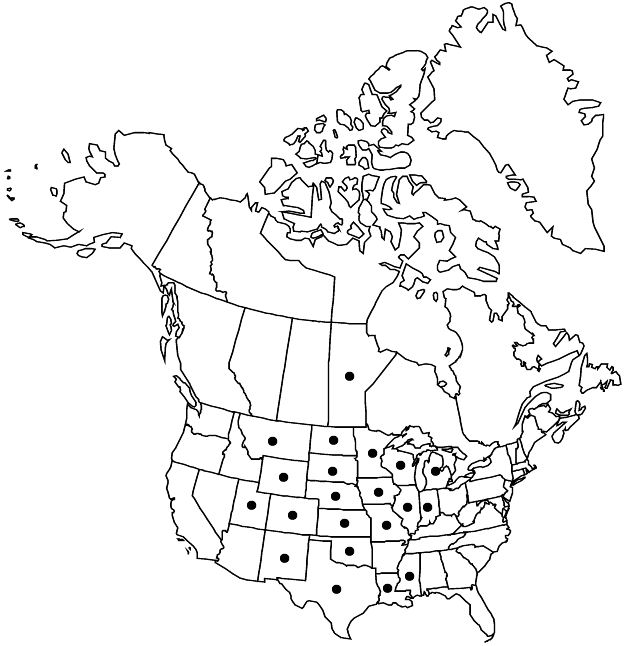Difference between revisions of "Euphorbia geyeri"
Boston J. Nat. Hist. 5: 260. 1845.
FNA>Volume Importer |
RevisionBot (talk | contribs) m (Bot: Adding category Revised Since Print) |
||
| (7 intermediate revisions by 3 users not shown) | |||
| Line 12: | Line 12: | ||
|name=Chamaesyce geyeri | |name=Chamaesyce geyeri | ||
|authority=(Engelmann) Small | |authority=(Engelmann) Small | ||
| + | |rank=species | ||
}} | }} | ||
|hierarchy=Euphorbiaceae;Euphorbia;Euphorbia sect. Anisophyllum;Euphorbia geyeri | |hierarchy=Euphorbiaceae;Euphorbia;Euphorbia sect. Anisophyllum;Euphorbia geyeri | ||
| Line 23: | Line 24: | ||
-->{{Treatment/Body | -->{{Treatment/Body | ||
| − | |distribution= | + | |distribution=Man.;Colo.;Ill.;Ind.;Iowa;Kans.;La.;Mich.;Minn.;Miss.;Mo.;Mont.;N.Dak.;N.Mex.;Nebr.;Okla.;S.Dak.;Tex.;Utah;Wis.;Wyo.;n Mexico. |
|discussion=<p>Varieties 2 (2 in the flora).</p><!-- | |discussion=<p>Varieties 2 (2 in the flora).</p><!-- | ||
--><p>The two varieties of <i>Euphorbia geyeri</i> have been distinguished in large part by the presence of conspicuous involucral gland appendages in <i></i>var.<i> geyeri</i> and the lack of appendages in <i></i>var.<i> wheeleriana</i>. The two varieties are recognized here, but the variation in the size and presence of involucral gland appendages in the closely related <i>E. bombensis</i> suggests that this might be a somewhat variable character in this group of species.</p><!-- | --><p>The two varieties of <i>Euphorbia geyeri</i> have been distinguished in large part by the presence of conspicuous involucral gland appendages in <i></i>var.<i> geyeri</i> and the lack of appendages in <i></i>var.<i> wheeleriana</i>. The two varieties are recognized here, but the variation in the size and presence of involucral gland appendages in the closely related <i>E. bombensis</i> suggests that this might be a somewhat variable character in this group of species.</p><!-- | ||
| Line 49: | Line 50: | ||
-->{{#Taxon: | -->{{#Taxon: | ||
name=Euphorbia geyeri | name=Euphorbia geyeri | ||
| − | |||
|authority=Engelmann | |authority=Engelmann | ||
|rank=species | |rank=species | ||
| Line 56: | Line 56: | ||
|basionyms= | |basionyms= | ||
|family=Euphorbiaceae | |family=Euphorbiaceae | ||
| − | |distribution= | + | |distribution=Man.;Colo.;Ill.;Ind.;Iowa;Kans.;La.;Mich.;Minn.;Miss.;Mo.;Mont.;N.Dak.;N.Mex.;Nebr.;Okla.;S.Dak.;Tex.;Utah;Wis.;Wyo.;n Mexico. |
|reference=None | |reference=None | ||
|publication title=Boston J. Nat. Hist. | |publication title=Boston J. Nat. Hist. | ||
|publication year=1845 | |publication year=1845 | ||
|special status= | |special status= | ||
| − | |source xml=https:// | + | |source xml=https://bitbucket.org/aafc-mbb/fna-data-curation/src/2e0870ddd59836b60bcf96646a41e87ea5a5943a/coarse_grained_fna_xml/V12/V12_17.xml |
|genus=Euphorbia | |genus=Euphorbia | ||
|section=Euphorbia sect. Anisophyllum | |section=Euphorbia sect. Anisophyllum | ||
| Line 67: | Line 67: | ||
}}<!-- | }}<!-- | ||
| − | -->[[Category:Treatment]][[Category:Euphorbia sect. Anisophyllum]] | + | --> |
| + | |||
| + | [[Category:Treatment]] | ||
| + | [[Category:Euphorbia sect. Anisophyllum]] | ||
| + | [[Category:Revised Since Print]] | ||
Latest revision as of 18:10, 6 November 2020
Herbs, annual, with taproot. Stems prostrate or slightly ascending, loosely mat-forming, 4–25(–45) cm, glabrous. Leaves opposite; stipules usually distinct, occasionally connate basally on lower side, usually deeply parted into 3 or more filiform segments, 0.7–1.5 mm, glabrous; petiole 1–2 mm, glabrous; blade oblong to oblong-obovate or oblong-elliptic, 4–12 × 2–6 mm, base slightly asymmetric, angled or rounded, with one side usually expanded into small, rounded auricle, margins entire, apex usually truncate, occasionally emarginate, abaxial surface pale grayish green, both surfaces glabrous; only midvein conspicuous or venation obscurely pinnate (larger leaves). Cyathia solitary or in small, cymose clusters at distal nodes; peduncle 1–2 mm. Involucre broadly campanulate, 1–1.5 × 0.7–0.9 mm, glabrous; glands 4, green to reddish, elliptic-oblong to nearly circular, slightly cupped to folded, 0.2–0.4 × 0.2–0.6 mm; appendages rudimentary to absent or white to reddish-tinged, usually rounded, sometimes pointed, (0–)0.5–1 × (0–)0.1–1.2 mm, distal margin entire or slightly toothed. Staminate flowers 5–20. Pistillate flowers: ovary glabrous; styles 0.2–0.6 mm, 2-fid nearly 1/2 length. Capsules globose-ovoid, 1.5–2 × 1.5–3 mm, glabrous; columella 1.5–1.9 mm. Seeds ashy white, ovoid, terete to bluntly subangled in cross section, 1.1–1.7 × 0.9–1.2 mm, smooth, with smooth brown line from top to bottom on adaxial side.
Distribution

Man., Colo., Ill., Ind., Iowa, Kans., La., Mich., Minn., Miss., Mo., Mont., N.Dak., N.Mex., Nebr., Okla., S.Dak., Tex., Utah, Wis., Wyo., n Mexico.
Discussion
Varieties 2 (2 in the flora).
The two varieties of Euphorbia geyeri have been distinguished in large part by the presence of conspicuous involucral gland appendages in var. geyeri and the lack of appendages in var. wheeleriana. The two varieties are recognized here, but the variation in the size and presence of involucral gland appendages in the closely related E. bombensis suggests that this might be a somewhat variable character in this group of species.
Euphorbia geyeri is widespread throughout the central United States in sandy soils. Populations at the eastern edge of the range are often considered adventive (for example, sandy soils along railroad grades in Michigan). Euphorbia geyeri resembles E. glyptosperma (both being entirely glabrous), but that species has serrulate leaves (near the apex) and strongly angled, transverse-ridged seeds whereas E. geyeri has entire leaves and smooth, rounded seeds.
Selected References
None.
Key
| 1 | Involucral gland appendages present; staminate flowers 5–9; seeds 1.1–1.4(–1.6) mm. | Euphorbia geyeri var. geyeri |
| 1 | Involucral gland appendages absent or rudimentary; staminate flowers 10–20; seeds 1.6–1.7 mm. | Euphorbia geyeri var. wheeleriana |